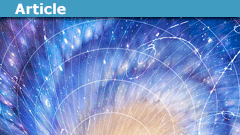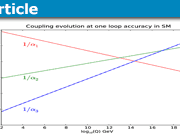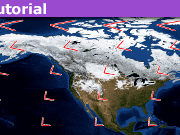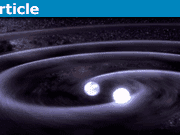Exploring General Relativity as a Gauge Theory
The fundamental interactions of the Standard Model are described by Yang-Mills theory. This is a gauge theory, which means the following: (1) Choose a group of global i.e. spacetime-independent symmetries and write down the Lie algebra which generates it, (2) ‘Gauge’ this algebra, i.e. make the symmetries spacetime-dependent, and (3) Introduce gauge fields which compensate for the local transformations. The local symmetries are realized on the gauge fields by the adjoint representation, and these gauge fields mediate the interactions. The other fields which are affected by these interactions then sit in other representations, like the fundamental one. In the Standard Model, the groups of symmetries which one uses to describe electromagnetic, weak, and strong interactions are U(1), SU(2), and SU(3). But how about that other (fundamental?) interaction called gravity?
Gravity is described by Einstein’s theory of General Relativity (GR). There one also deals with local symmetries, namely general coordinate transformations (GCT’s) in spacetime and local Lorentz transformations (LLT’s) in the tangent spacetime. It turns out that this theory can also be described as a gauge theory, albeit different from Yang-Mills. So in what follows, we’ll look at this claim, the differences with Yang-Mills theory, and the central role of ‘removing the local translations’.
The global symmetries one has when gravity is ‘switched off’ are the Poincaré symmetries of spacetime. This flat spacetime has Minkowski metric [itex]\eta_{AB}[/itex], and the symmetries are generated by spacetime-translations [itex]P_A[/itex] and spacetime-rotations (i.e. Lorentz transformations) [itex]M_{AB}[/itex]. On the coordinates [itex]\{x^{A}\}[/itex] of spacetime (which can be identified with the tangent space) they act infinitesimally like
\begin{align}
\delta_P x^A & = \zeta^A \,, \nonumber\\
\delta_M x^A & = \lambda^A{}_B x^B \,. \label{infpoincoord}
\end{align}
These transformations keep the spacetime interval invariant. Here [itex]. A,B,\ldots[/itex]. are running from 0 to (D-1) and are tangent-space indices. Just to keep notation a bit tractable, I won’t be bothered too much with whether these flat indices should be up or down. The Poincaré transformations \eqref{infpoincoord} generate the Poincaré algebra, as you can check:
\begin{align}
[P_{A},P_{B}] & = 0 \,, \nonumber\\
[M_{BC},P_{A}] & = -2\eta_{A[B}P_{C]}\,, \nonumber\\
[M_{CD},M_{EF}] & = 4 \eta_{[C [E}M_{F]D]} \,. \label{Poincarealgebra}
\end{align}
The [itex] [AB][/itex] means antisymmetrization with weight one such that e.g. for an antisymmetric tensor [itex]F_{AB}[/itex] one has [itex]F_{AB} = F_{[AB]}[/itex]. From this one obtains the non-zero structure constants
\begin{equation}
f_{\{BC\}A}^D = -2 \eta_{A[B}\delta_{C]}^D, \ \ \ f_{\{CD\}\{EF\}}^{\{AB\}} = 4\eta_{[C[E}\delta_{F]}^{[A} \delta_{D]}^{B]}\,.
\end{equation}
So now we gauge this algebra. In this gauging we first treat the transformations as acting on an abstract, internal space which only later on (!) will be identified as the tangent space. The ‘translational’ gauge field is (suggestively) called [itex]e_{\mu}{}^A[/itex] while the ‘rotational’ gauge field is [itex]\omega_{\mu}{}^{AB}[/itex]. Here the curved indices [itex]\mu\nu\ldots[/itex] indicate spacetime indices. These fields sit in the adjoint representation of the algebra \eqref{Poincarealgebra}. The non-zero local Poincaré symmetries are then realized as follows:
\begin{align}
\delta_P e_{\mu}{}^A & = \partial_{\mu}\zeta^A – \omega_{\mu}{}^{AB} \zeta^B , \ \ \delta_M e_{\mu}{}^A = \lambda^{AB}e_{\mu}{}^B \,, \nonumber\\
\delta_M \omega_{\mu}{}^{AB} & = \partial_{\mu}\lambda^{AB} + 2 \lambda^{C[A}\omega_{\mu}{}^{B]C}\,. \label{The gauge transformations}
\end{align}
You can check for yourself that these transformations realize the algebra \eqref{Poincarealgebra} on the two gauge fields by calculating the commutators. Besides the gauge transformations the two gauge fields are spacetime vectors, and they transform as such under GCT’s [itex]\delta x^{\mu} = \xi^{\mu}(x)[/itex]:
\begin{equation}
\delta_{\xi} e_{\mu}{}^A = \xi^{\lambda} \partial_{\lambda} e_{\mu}{}^A + \xi^{\lambda}\partial_{\mu} e_{\lambda}{}^A \,,\label{gcte}
\end{equation}
and similar for [itex]\omega_{\mu}{}^{AB}[/itex]. The field strengths of the two gauge fields read
\begin{align}
R_{\mu\nu}{}^A(P) & = 2 \Bigl( \partial_{[\mu}e_{\nu]}{}^A – \omega_{[\mu}{}^{AB} e_{\nu]}{}^B
\Bigr) \,,\nonumber\\
R_{\mu\nu}{}^{AB}(M) & = 2 \Bigl( \partial_{[\mu}\omega_{\nu]}{}^{AB} – \omega_{[\mu}{}^{CA}\omega_{\nu]}{}^B{}_C \Bigr) \,. \label{PoinCurvatures}
\end{align}
These field strengths transform covariantly under the gauge transformations, i.e. without derivatives on the parameters [itex]\zeta^A[/itex] and [itex]\lambda^A{}_B[/itex].
Untill now this all seems a bit formal and you can wonder what the relation is between our gauge theory and Einstein’s GR. In GR one has GCT’s and LLT’s but no local translations. So if we could somehow get rid of these local translations, we would be in business. This can be achieved by the following very important constraint:
\begin{equation}
R_{\mu\nu}{}^A(P) = 0 \,. \label{RPconstraint}
\end{equation}
We just put the field strength of local translations to zero! To see why this does the trick, you have to look at the following, also very important, relation
\begin{align}
\delta_{\xi}(\xi^{\lambda})e_{\mu}{}^A & +
\xi^\lambda R_{\mu\lambda}{}^A(P)
– \delta_P (\zeta^C = \xi^{\lambda}e_{\lambda}{}^{C})e_{\mu}{}^A \nonumber\\
& – \delta_M (\lambda^{C}{}_D = \xi^{\lambda} \omega_{\lambda}{}^{C}{}_D)e_{\mu}{}^A = 0 \,. \label{VIE}
\end{align}
A similar relation holds for [itex]\omega_{\mu}{}^{AB}[/itex]. You see that if we take field dependent parameters in our gauge transformations of a particular gauge field, there is a relation between all the gauge transformations, GCT’s and the field strength! Similar relations hold in every gauge theory. For instance, in ordinary U(1) Yang-Mills theory with gauge field [itex]A_{\mu}[/itex] and gauge transformation [itex]\delta_{\Lambda} A_{\mu} = \partial_{\mu}\Lambda[/itex] one has
\begin{equation}
\delta_{\xi}(\xi^{\lambda})A_{\mu} + \xi^{\lambda}F_{\mu\lambda} – \delta_{\Lambda}(\Lambda = \xi^{\lambda}A_{\lambda})A_{\mu} = 0 \,, \label{VIEMax}
\end{equation}
as you can check by yourself. So if we would put the field strength in eqn.\eqref{VIEMax} to zero, GCT’s and field-dependent gauge transformations become the same. These field-dependent transformations do not span a U(1) algebra anymore, i.e. they do not commute! Instead, they form what is called a soft algebra, which is an algebra having field-dependent structure ‘constants’. In the U(1)-case this is not so interesting; having just one Abelian field strength, we would make our gauge field pure gauge by the zero field strength constraint. So let’s return to our Poincaré theory. Using the constraint \eqref{RPconstraint} in the relation \eqref{VIE}, we get
\begin{equation}
\delta_P (\xi^{\lambda}e_{\lambda}{}^{C})e_{\mu}{}^A = \delta_{gct}(\xi^{\lambda})e_{\mu}{}^A
– \delta_M (\xi^{\lambda} \omega_{\lambda}{}^{CD})e_{\mu}{}^A \,. \label{VIE2}
\end{equation}
This means that if we can reformulate every gauge parameter [itex]\zeta^C[/itex] as [itex]\xi^{\lambda}e_{\lambda}{}^{C}[/itex], we can effectively rewrite every local translation in terms of the GCT’s and LLT’s! To put it differently, we want to get a one-to-one relation between [itex]\zeta^C[/itex] and [itex]\xi^{\lambda}[/itex] such that we we dump the local translations. This can be achieved by interpreting [itex]e_{\lambda}{}^{C}[/itex] as an invertible matrix. Hence, we introduce ‘inverse’ fields for it:
\begin{equation}
e_{\mu}{}^A e^{\mu}{}_B = \delta^A_B, \ \ \ e_{\mu}{}^A e^{\nu}{}_A = \delta^{\nu}_{\mu}\ \ \ \,.
\end{equation}
As such we can relate
\begin{equation}
\zeta^A \equiv \xi^{\lambda}e_{\lambda}{}^{A}, \ \ \ e^{\mu}{}_A \zeta^A \equiv \xi^{\mu} \,.
\end{equation}
With the relation [itex]\zeta^C \equiv \xi^{\lambda}e_{\lambda}{}^{C}[/itex] in eqn. \eqref{VIE2} we effectively have removed the local translations from our algebra; they can all be written as linear combinations of GCT’s and LLT’s. The fact that this deforms our original Poincaré algebra we started from (the local translations don’t commute anymore) doesn’t bother us. On the contrary: it is expected since GCT’s generally don’t commute!
The fun is not over yet; the constraint \eqref{RPconstraint} does something else for us. Namely, now we have an inverse for the gauge field at our disposal, we notice that the field [itex]\omega_{\mu}{}^{AB}[/itex] appears algebraically in the constraint with an invertible matrix and that its number of independent components matches the independent number of constraints in \eqref{RPconstraint}. This means we can solve completely for it, namely
\begin{equation}
\omega_{\mu}{}^{AB} = 2e^{\lambda [A} \partial_{[\lambda}e_{\mu]}{}^{B]} +
e_{\mu}{}^C e^{\lambda\,A} e ^{\rho\,B } \partial_{[\lambda}e_{\rho]}{}^C\,. \label{omega}
\end{equation}
So there you have it. Imposing the constraint \eqref{RPconstraint} enables us to (1) ‘remove’ the local translations from our algebra and (2) makes the field [itex]\omega_{\mu}{}^{AB}[/itex] dependent, leaving us with [itex]e_{\mu}{}^A[/itex] as only independent field. Now a couple of remarks are in order here.
First, we are tempted to identify [itex]e_{\mu}{}^A[/itex] with the vielbein and [itex]\omega_{\mu}{}^{AB}[/itex] with the spin connection of GR. This means our indices A,B,… label the tangent space or ‘inertial’ indices. It’s okay to succumb to this temptation. The constraint \eqref{RPconstraint} then simply says that torsion vanishes, which we know is true in GR.
Second, we see that we did two things that looks quite alien to Yang-Mill’s theories: we’ve put one field strength to zero and we introduced an ‘inverse gauge field’ to remove the local translations.
Third, you might worry about the transformation of the spin connection, now being a dependent field. Worry not: the variations of the constraint \eqref{RPconstraint} must also be zero, which indicates that the spin connection still transforms under LLT’s as \eqref{The gauge transformations} dictates. If you like tedious calculations, this can also be checked by applying the LLT [itex]\delta_M e_{\mu}{}^A = \lambda^A{}_B e_{\mu}{}^B[/itex] directly to the solution \eqref{omega}. Dito for the GCT \eqref{gcte}.
Fourth: how are solving for the spin connection and removing the local translations from the vielbein related? They both follow from our constraint \eqref{RPconstraint} but seem two completely unrelated things! Their relation however is obscured by the fact that we applied the gauging procedure to the Poincaré algebra. This algebra can be obtained from the (Anti)deSitter algebra ((A)dS) by a so-called Inönü-Wigner contraction, i.e. a degenerate transformation on the Lie algebra which makes some structure constants to vanish. In this (A)dS algebra, the commutator [P,P] = 0 of the Poincaré algebra gets replaced by
\begin{equation}
[P_A, P_B] = \Lambda M_{AB} \,, \label{Sit}
\end{equation}
where [itex]\Lambda[/itex] is the cosmological constant. As a result, the transformations \eqref{The gauge transformations} now change: the a priori independent spin-connection now also transforms under local translations. At first sight, this looks like a disaster. Because by writing down the analog of \eqref{VIE2} for the spin connection you could think that in order to remove the local translations from the spin connection, we now also have to put the rotational field strength to zero. However, this is not necessary. The constraint \eqref{RPconstraint} already removes the local translations from the spin connection by making this field completely dependent on the vielbein. This fact is obscured in the Poincaré algebra because there the independent spin connection didn’t transform under local translations in the first place. The Inönü-Wigner contraction consists of sending [itex]\Lambda \rightarrow 0[/itex] in eqn.\eqref{Sit}, giving us the Poincaré algebra again.
Fifth, we still have to derive the dynamics. The Einstein-Hilbert action is
\begin{equation}
S \sim \int e^{\mu}{}_A e^{\nu}{}_B R_{\mu\nu}{}^{AB}(M) |e| d^D x \,,
\end{equation}
with [itex]|e|[/itex] the (absolute value of the) determinant of the vielbein. It has a nice property that varying with respect to the spin connection gives us the constraint \eqref{RPconstraint}. This approach to taking both the vielbein and spin connection a priori as being independent is known as the Palatini formalism. That makes us happy because this is exactly what we do in our gauging procedure. However, the Einstein-Hilbert action is linear in the field strength and not quadratic, as for Yang-Mills theory. If one starts from the gauge theory of (A)dS, one can indeed write down an action which is quadratic in the full field strength [itex]R_{\mu\nu}{}^A P_A + R_{\mu\nu}{}^{AB} M_{AB}[/itex] and invariant under parity, GCT’s and LLT’s. Expanding this full field strength gives us a topological term and the Einstein-Hilbert action including the cosmological constant. So we see that the Einstein-Hilbert action can also be obtained from a Lagrangian quadratic in the full field strength. This is explained in ref.[7].
Sixth and last: why do we care? Well, to start with, it gives us a different view on GR. Different views are useful for being ‘a good physicist’, as Feynman once explained in his The Character of Physical Law. But the great strength of this gauging procedure lies in the fact that it can be applied to all kinds of other Lie algebras, giving all kinds of different theories of gravity! The first example is minimal supersymmetry in D=4 described by the super-Poincaré algebra [3,4,5]. This algebra contains a spinorial supercharge [itex]Q[/itex], with (anti)commutators reading schematically [itex]\{Q,Q\} \sim P[/itex] and [itex][M,Q] \sim Q[/itex]. The supercharge gauge field is the gravitino, and we see that [itex]\{Q,Q\} \sim P[/itex] introduces an extra term in the translational field strength. Putting it to zero again to remove the local translations now introduces torsion. A similar thing can be done for the super-AdS algebra, whereas super-dS is not allowed by the Jacobi identities. Other algebras on which the procedure can be applied are (among others) the (super)conformal-, (super)Bargmann-, (super)Newton-Hooke (the non-relativistic version of (A)dS), (super)Schrödinger- and Carroll-algebras. The (super)conformal gives us a method to couple matter to Poincaré Supergravity, the notorious superconformal tensor calculus [6]. The (super)Bargmann-, (super)Newton-Hooke- and (super)Schrödinger-algebras give us (super)Newton-Cartan [8,9], i.e. non-relativistic but general-covariant theories of gravity. The Carroll algebra gives us general-covariant, ultrarelativistic gravity [10]. I haven’t checked it, but I’m pretty sure the gauging procedure as outlined here can also be applied to other deformations of the Poincaré algebra, such as ‘Doubly Special Relativity’ [11].
My outline here stresses the role of the curvature constraint \eqref{RPconstraint}. It’s often called conventional because one uses it to solve for the spin connection. However, as I understand it, this is a consequence of something deeper: it allows us to remove the local translations from the algebra while maintaining its corresponding gauge field.
For further reading (including both pedagogical and original exposures), see
[1] R. Utiyama, ”Invariant theoretical interpretation of interaction”, Phys. Rev. 101, 1597 (1955), http://dx.doi.org/10.1103/PhysRev.101.1597
[2] T.W.B. Kibble,”Lorentz invariance and the gravitational field”, J.Math.Phys. 2 (1961) 212-221,
http://dx.doi.org/10.1063/1.1703702
[3] S.W. MacDowell, F. Mansouri, ”Unified Geometric Theory of Gravity and Supergravity”, Phys.Rev.Lett. 38 (1977) 739, https://doi.org/10.1103/PhysRevLett.38.1376
[4] A.H. Chamseddine and P.C. West, ”Supergravity as a Gauge Theory of Supersymmetry”, Nucl.Phys. B129 (1977) 39-44
(1977), https://doi.org/:10.1016/0550-3213(77)90018-9
[5] T. Ortin, ”Gravity and strings”, Cambridge Monographs on Mathematical Physics
Cambridge University Press (2015-03-26)
ISBN: 9780521768139, 9780521768139 (Print)
[6] D.Z. Freedman and A. Van Proeyen, ”Supergravity”, Cambridge, UK: Cambridge Univ. Press (2012-05-20)
ISBN: 9781139368063 (eBook), 9780521194013 (Print)
[7] P.G.O. Freund,“Introduction To Supersymmetry”, Cambridge Monographs on Mathematical Physics
Cambridge, UK: Cambridge Univ. Press (2012-05-11)
ISBN: 9781139241939 (eBook), 9780521356756 (Print)
[8] R. Andringa, ”Newton-Cartan gravity revisited”, http://www.rug.nl/research/portal/en/publications/newtoncartan-gravity-revisited(fb063f36-42dc-4529-a070-9c801238689a).html!null
[9] E.A. Bergshoeff, J. Rosseel and T. Zojer, ”Newton-Cartan supergravity with torsion and Schrodinger supergravity”, JHEP 1511 (2015) 180 (2015-11-25), https://arxiv.org/abs/1509.04527
[10] J. Hartong, ”Gauging the Carroll Algebra and Ultra-Relativistic Gravity”, JHEP 1508 (2015) 069
(2015-08-14), https://arxiv.org/abs/1505.05011
[11] G.A. Camelia, ”Relativity in space-times with a short-distance structure governed by an observer-independent (Planckian) length scale”, Int.J.Mod.Phys. D11 (2002) 35-60, https://arxiv.org/abs/gr-qc/0012051
Loves physics, philosophy and a lot of other stuff. Studied Theoretical Physics, obtained a PhD in Quantum Gravity and Cosmology research. Currently teaching mathematics at a university.








I can't keep up with the mathematical notation.I wish there were some illustrations.
[QUOTE="vanhees71, post: 5615499, member: 260864"]There are many more vacuum solutions of Einstein's field equations than just the Schwarzschild solution, e.g., the Friedmann-Lemaitre-Robertson-Walker solution that is utmost important for cosmology. These solutions have no black-hole singularities but rather a big bang/crunch singularity. Of course another solution is Minkowski spacetime which has no sinularities at all.[/QUOTE]The cosmological solutions are usually non-vacuum. I assume you meant something else than what you wrote.
There are many more vacuum solutions of Einstein's field equations than just the Schwarzschild solution, e.g., the Friedmann-Lemaitre-Robertson-Walker solution that is utmost important for cosmology. These solutions have no black-hole singularities but rather a big bang/crunch singularity. Of course another solution is Minkowski spacetime which has no sinularities at all.
[QUOTE="haushofer, post: 5609379, member: 20128"]Mmmm, I have to think about that, since this point arises in all dimensions.[/QUOTE]I was not implying otherwise just pointing to the similarity of concept with the gravitational anomaly specifically in the 4-spacetime and even though what you explained about Poincare gauge theory of gravity is not limited to a certain dimensionality, it makes little sense to apply it for instance to the 2+1 GR that in vacuum is trivially flat(no weyl curvature so it's pretty worthless physically.I have another question, with the gauge procedure described in the insight article, starting from Minkowski 4 spacetime and gauging and getting rid of the translations by making torsion vanish, a gravitational vacuum is obtained that is equivalent to the GR equations in vacuum, i.e. to the Schwarzschild metric, but is not singular(just like Einstein-Cartan gravity theory is not singular), so this is a gauge from wich black hole physics is not obtainable even if the classical tests of relativity are. I was under the impression that any gravitational theory of the vacuum with rotational symmetry, that can be expressed as Rab=0 would give the singular Schwarzschild solution, per Birkhoff's theorem, so I'm not sure what exactly I'm overlooking.
Mmmm, I have to think about that, since this point arises in all dimensions.
[QUOTE="haushofer, post: 5607471, member: 20128"]The way I understand the procedure, is that the gauging procedure gives you GR with vacuum equations only. This is because the only gauge fields are the dependent spin connection and the vielbein (metric). After that you couple the theory to matter, but these matter fields in general will not be gauge fields anymore of an extension of the Poincaré algebra. An exception to this is the N=1 super-Poincaré theory in D=4, in which you introduce a gravitino; this field can be treated like the gauge field of the supertransformations. So after coupling of the matter, the spin connection will be given by the first order formalism and for fermions will obtain extra terms compared to the gauging.Spin-1/2 fields cannot be considered as gauge fields of some 'extra generators' of the Poincaré algebra afaik (they don't even carry a vector index). So they introduce torsion because of the first order formalism (they couple to the spin connection), not because they appear in the curvature of local translations.As such the gauging procedure for me is a way of obtaining the vacuum equations, but as soon as one wants to couple matter, the result in general will not be obtainable by a gauging procedure directly. If this would be the case, constructing supergravity theories would be much easier! So if I couple fermions to GR, I don't consider the underlying algebra anymore, but use the first order formalism to derive the spin connection.Hope this clarifies your question.[/QUOTE]Yes, thanks, this is basically the gravitational gauge anomaly for even dimensional spacetimes in the field theoretic context.
See also the discussion here, https://www.physicsforums.com/insights/11d-gravity-just-torsion-constraint/ where it is discussed also for D=11 sugra :)
Hi RockyMarciano,sorry for the late answer.The way I understand the procedure, is that the gauging procedure gives you GR with vacuum equations only. This is because the only gauge fields are the dependent spin connection and the vielbein (metric). After that you couple the theory to matter, but these matter fields in general will not be gauge fields anymore of an extension of the Poincaré algebra. An exception to this is the N=1 super-Poincaré theory in D=4, in which you introduce a gravitino; this field can be treated like the gauge field of the supertransformations. So after coupling of the matter, the spin connection will be given by the first order formalism and for fermions will obtain extra terms compared to the gauging.Spin-1/2 fields cannot be considered as gauge fields of some 'extra generators' of the Poincaré algebra afaik (they don't even carry a vector index). So they introduce torsion because of the first order formalism (they couple to the spin connection), not because they appear in the curvature of local translations.As such the gauging procedure for me is a way of obtaining the vacuum equations, but as soon as one wants to couple matter, the result in general will not be obtainable by a gauging procedure directly. If this would be the case, constructing supergravity theories would be much easier! So if I couple fermions to GR, I don't consider the underlying algebra anymore, but use the first order formalism to derive the spin connection. If you want to see how matter couplings can be derived systematically in supergravity theories, you can check the "Super conformal tensor calculus", in which conformal symmetries are used as a trick to couple matter multiplets to Poincaré-SUGRA. Hope this clarifies your question.
So this brings me back to the second question in my post #7. Once we make effective the necessary constraining condition(getting rid of "local translations" by setting the torsion to zero and therefore restricting to vacuum) to gauge GR's symmetry (CGTs) according to the equivalence principle(LLTs) acting as local symmetry, how can we introduce a stress-energy tensor in such a gauge theory?
I see. The fermionic action for e.g. spin-1/2 contains a kinetic term[tex]bar{psi} gamma^{mu} D_{mu} psi = bar{psi} gamma^{mu} Big( partial_{mu} – frac{1}{4}gamma_{AB}, omega_{mu}{}^{AB} Bigr)psi[/tex]so in the first order formulation the variation with respect to the spin connection picks up a term[tex] – frac{1}{4} bar{psi} gamma^{mu} gamma_{AB} psi[/tex]giving torsion. The same goes for spin-3/2 and the Rarita-Schwinger action. This corresponds in the N=1,D=4 case to the gauging-argument I gave earlier for the gravitino.
[QUOTE="haushofer, post: 5601737, member: 20128"]I'm not sure to which extent the generality is of the statement "fermions add torsion".[/QUOTE]My understanding is that, with or without SUSY, the contribution of fermions to the energy-momentum tensor has a spin piece which is not symmetric, and thus always gives you nonzero torsion (due to the non-symmetric Ricci tensor). But the torsion is always non-propagating; i.e., it is nonzero only where the fermion fields are nontrivial.
[QUOTE="RockyMarciano, post: 5600984, member: 585697"]Ok, that was my initial undestanding, because only with the R(P) i.e. the torsion set to zero one recovers the Riemannian Bianchi identities, but in vacuum only. Then you can couple matter with spin but you are again back to the non-Riemannian connection and tensors, right?[/quote]If you mean with "non- Riemannian" "torsionfull", then not necessarily. As fas as I know, spin-1 does not introduce torsion. Fermions can introduce torsion, and one example of this can be seen by the gauging of the N=1 super-Poincaré algebra. This gives you the gravitino gauge field psi, and the $${Q,Q}=P$$ adds an extra term in the (now super!)covariant P-curvature, which schematically becomes[tex]hat{R}^A(P) = d e^A – omega^{AB} wedge e^B – bar{psi} gamma^A psi[/tex]So setting this to zero now gives[tex] d e^A – omega^{AB} wedge e^B = bar{psi} gamma^A psi[/tex]instead of zero. The left hand side is the antisymmetric part of the connection, [itex]Gamma^A_{[munu]}[/itex] due to the Vielbein postulate.I'm not sure to which extent the generality is of the statement "fermions add torsion".
PGT (or Poincare gauge theory) is essentially the creation of Friedrich Hehl and his co-workers based on the article by Kibble in the JMP. That, in turn, was based on the (I would call revolutionary) idea of R. Utyiama who, in turn, adapted the original idea of H. Weyl with the subsequent work by E. Cartan and the Russians Ivanenko and Fock. There's a book treating PGT and other gravity theories at depth which was written by Milutin Blagojevic https://www.amazon.com/Gravitation-Symmetries-Energy-Physics-Cosmology/dp/0750307676/ref=sr_1_2?s=books&ie=UTF8&qid=1477257936&sr=1-2&keywords=Blagojevic+Gravity and, to me, totally compensates the (well written, however incomplete) treatment in Ramond's book on QFT or the one in Weinberg's book on GR.
[QUOTE="haushofer, post: 5600962, member: 20128"]Ah, I see. Yes, I haven't stressed it too much, but the idea is that the gauging procedure gives the vacuum equations. As far as I can see those are exactly equivalent to the vacuum equations of GR. After that you can couple matter to your theory.[/QUOTE]Ok, that was my initial undestanding, because only with the R(P) i.e. the torsion set to zero one recovers the Riemannian Bianchi identities, but in vacuum only. Then you can couple matter with spin but you are again back to the non-Riemannian connection and tensors, right?[QUOTE]It's been a while since I've read that Kibble paper, but I don't see how one can keep torsion while removing the local translations: the R(P) curvature is the torsion. So R(P)=0 puts the torsion to zero, and the Bianchi identities then give you the corresponding symmetries on the Riemann tensor.[/QUOTE]Oh, sure. Sorry if that part was confused in my post, certainly getting rid of the torsion and of the local translations is in this case equivalent. The Einstein-Cartan theory is what you get before setting R(P) to 0.[QUOTE]I wrote this Insight after having a discussion with Urs here,https://www.physicsforums.com/insights/11d-gravity-just-torsion-constraint/Maybe you find that interesting too :)[/QUOTE]I'll take a look, thanks.
Ah, I see. Yes, I haven't stressed it too much, but the idea is that the gauging procedure gives the vacuum equations. As far as I can see those are exactly equivalent to the vacuum equations of GR. After that you can couple matter to your theory.It's been a while since I've read that Kibble paper, but I don't see how one can keep torsion while removing the local translations: the R(P) curvature is the torsion. So R(P)=0 puts the torsion to zero, and the Bianchi identities then give you the corresponding symmetries on the Riemann tensor.I wrote this Insight after having a discussion with Urs here,https://www.physicsforums.com/insights/11d-gravity-just-torsion-constraint/Maybe you find that interesting too :)
I've managed to get a copy of the second referenced paper(Kibble) in order to get some more understanding and maybe get up to speed on the subject of the insights article and what I found at the end of its section 6 is that after the gauging procedure, that includes removing the local translations and writing them as linear combinations of GCTs and LLTs as mentioned in the insight, what is obtained is a gauge theory of gravitation that is not exactly GR but the variant known as Einstein-Cartan-Sciama-Kibble theory, that doesn't have symmetric connection or Ricci tensors because it has torsion that allows to couple with matter with spin. Only then you can set the torsion to zero and then you get not the full EFE but the vacuum field equations of GR as I thought.
[QUOTE="haushofer, post: 5600084, member: 20128"]I think I don't really understand your statement " the curvature constraint only applies to certain isolated central objects situations"[/QUOTE]Maybe I'm misinterpreting what you mean by R(P)=0? I thought you meant by it a constraint that only applies in vacuum i.e. where Rab=0.
I'm not sure what you mean, so I hope this answer satisfies. The Bianchi identities for both curvatures imply, with the constraint R(P)=0 and the Vielbein postulate, the usual Bianchi identies for the Riemann tensor. These identities continue to hold when we couple the theory to matter, so I don't see any problem here.I think I don't really understand your statement " the curvature constraint only applies to certain isolated central objects situations"
Interesting insight.Maybe you could clarify more about the difference between GR gauge and Yang-Mills gauge. You have delved into how to keep GCTs while removing local translations by using a curvature constraint. One first question is that this curvature constraint comes about through the differential Bianchi identities(that reflect the dependencies that Noether's second theorem for local gauge theories talk about in her seminal 1918 article) in the absence of local curvature source, so it can be viewd as an analogous for instance to the Ward identities in QED that are obtained automatically by applying Noether's second theorem in the context of QFT, so wouldn't you say this is a common point between Yang-Mills and GR gauges rather than the difference?My other worry that I'm not completely sure if you have addressed in the insight, is that this constraint, if I have understood correctly what you refer to by it- the constraint leading to vacuum field equations-, is not a general feature of GR though, it only applies to certain isolated central objects situations. But curvature is indeed a general feature of GR as are the differential Bianchi identities that make clear the impossibility of using flat coordinates globally in a curved spacetime. So is GR only a gauge theory for those special isolated in vacuum objects cases? But then how are GCTs together with the LLTs kept in the general case when the curvature constraint is not present?. The dependencies and the Bianchi identities are still there, how are the local translations removed in the general case?
Added :)
Great article. It would be great if you could put the complete references at the end, e.g., for the first oneR. Utiyama, Invariant theoretical interpretation of interaction, Phys. Rev. 101, 1597 (1955)http://dx.doi.org/10.1103/PhysRev.101.1597
Great Insight @haushofer!
Thanx, sloppiness :P
Nice read.Just to nitpick: The gauge group corresponding to electromagnetism is U(1), not SU(1) (SU(1) is the trivial group and therefore not very exciting to build a Yang-Mills theory on). Also, the U(1) in the SM before spontaneous symmetry breaking is not the electromagnetic U(1) (the generator is hypercharge, not charge) and the SU(2) of the SM is not just related to weak interactions. Upon SSB, the U(1)xSU(2) symmetry of the SM is broken into the electromagnetic U(1), whose generator is a linear combination of the hypercharge U(1) and one of the SU(2) generators.